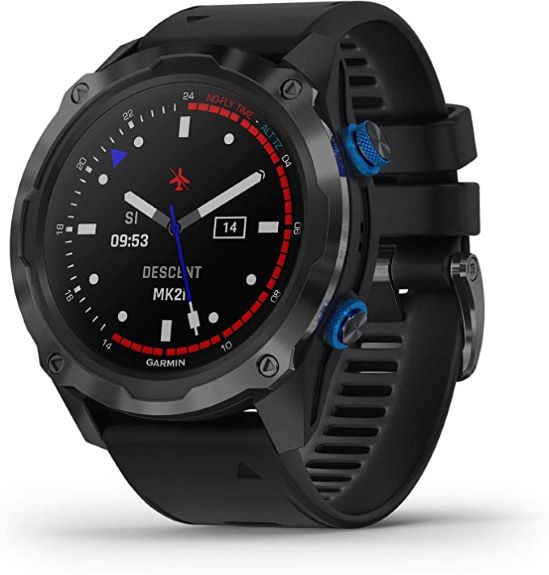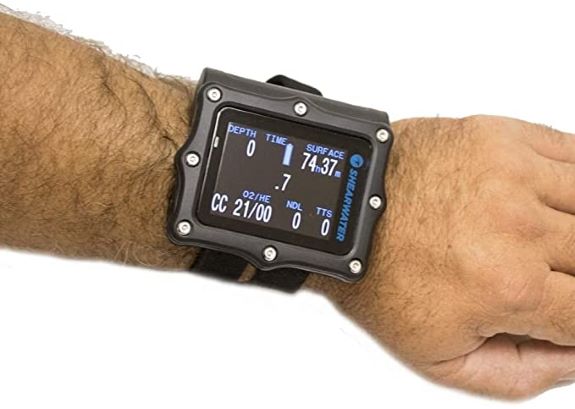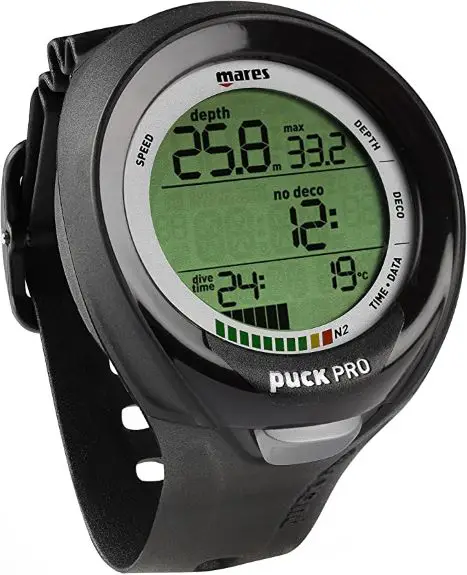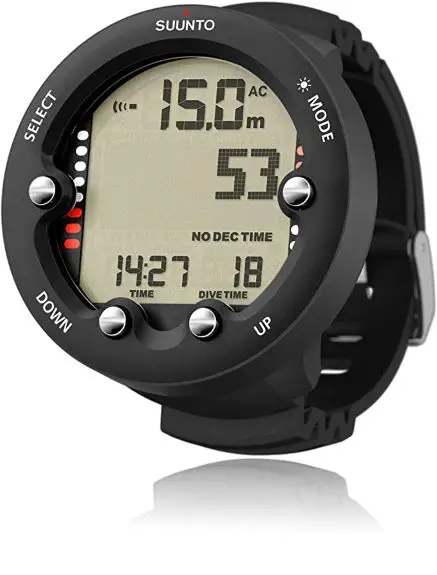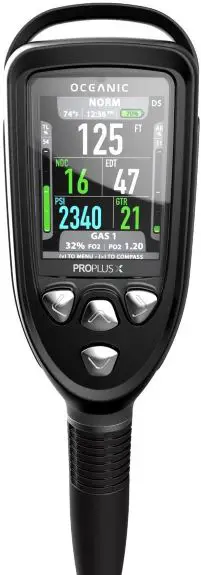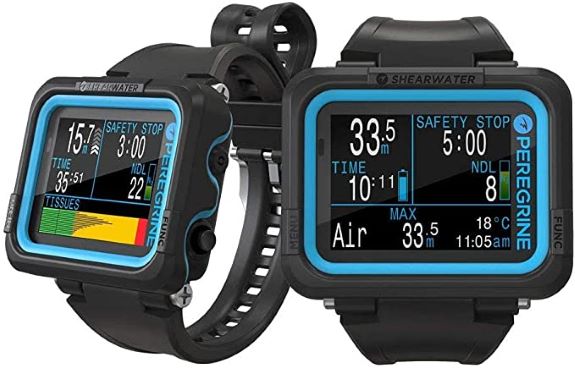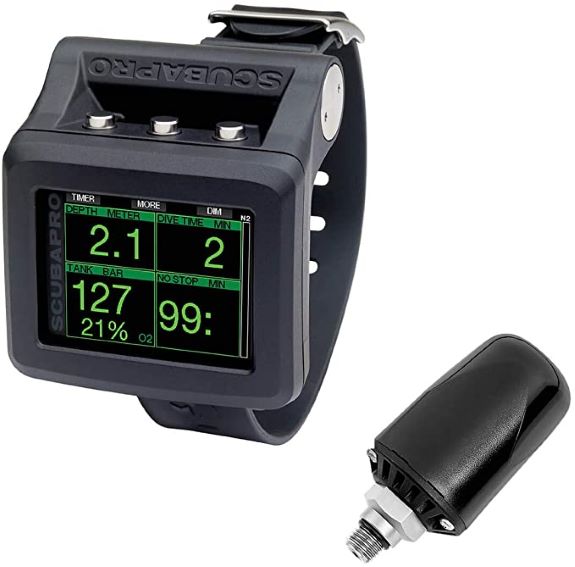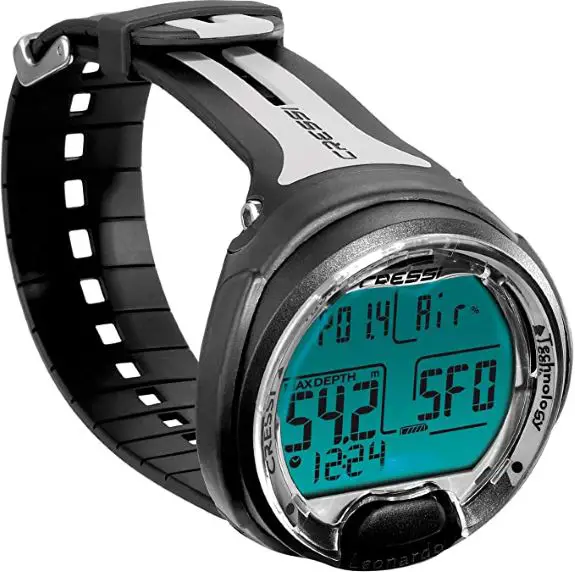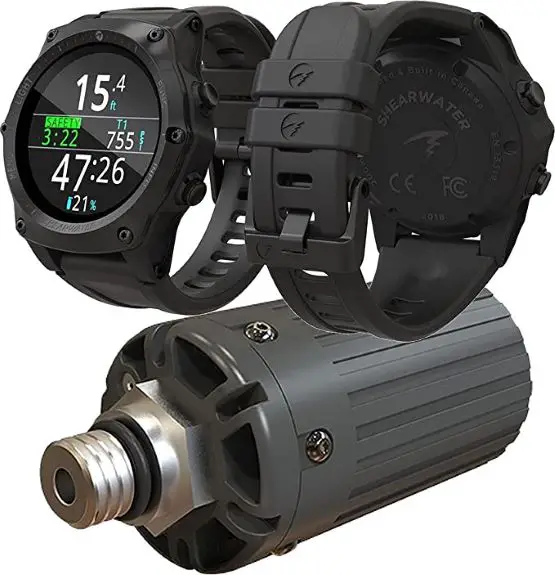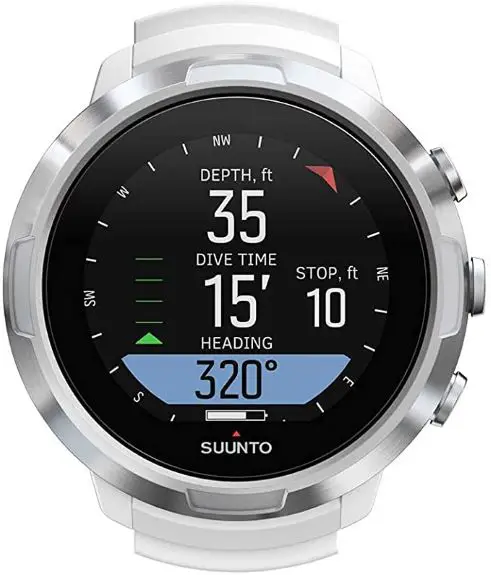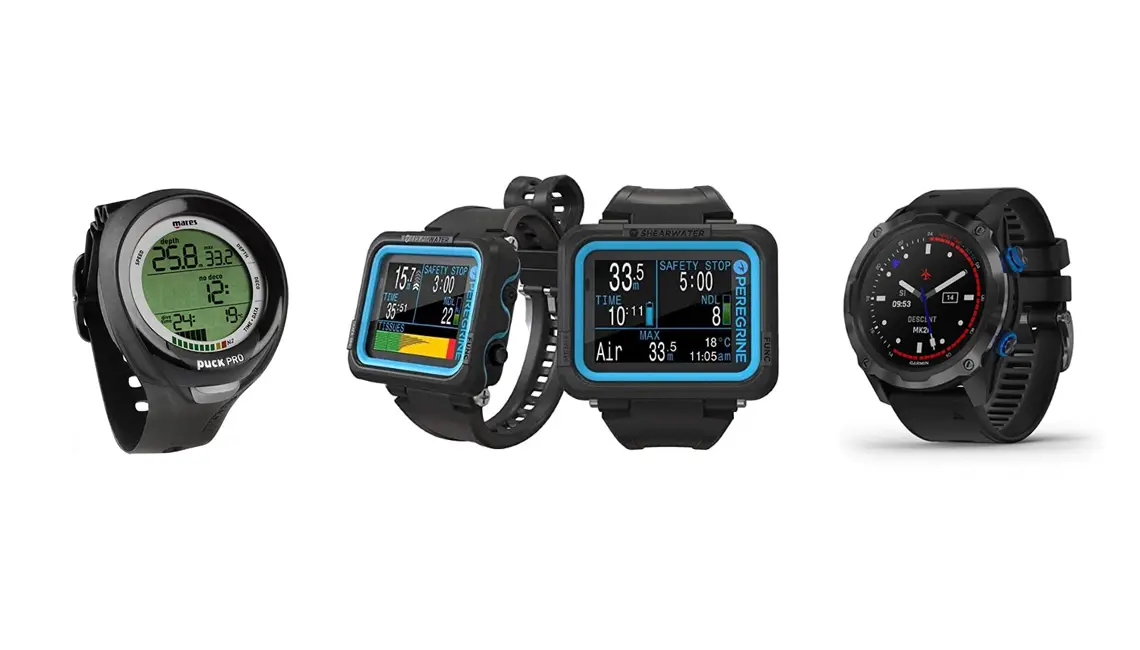
Whether you’re shopping for your first dive computer or need an upgrade, it’s important to choose the best dive computer for your unique needs. Make sure you understand the different features to look for in the top dive computers for recreational and technical scuba divers.
What is a dive computer?
Back in the day, scuba divers relied on dive tables to calculate vital information and plan their dives. These days, we have dive computers that automate the process. A dive computer uses algorithms to record — in real-time — essential information as you dive. This dive data includes current and maximum depth, the time elapsed, ascent rates, safety stop and decompression times, when it’s safe to fly, and more.
What is the difference between a console dive computer and a wrist computer?
There are two primary dive computer designs: console and wrist dive computers. Console computers attach to your regulators along with your pressure gauge. Meanwhile, wrist computers resemble a wristwatch.
Ultimately, both styles function similarly, so the choice really comes down to the design that you prefer. Wrist-style computers are more versatile and popular, but console computers are simple and easy to read. Many divers even choose to dive with both a watch-style dive computer and a console computer for extra security should one fail during a dive.
What should I look for when buying a dive computer?
With so many dive computers to choose from, it can be hard to find the best one for you! So while you shop, consider the quality of the computer, what gas mixes you use, what modes you need, and your preferred user interface.
Quality
Recreational divers rely heavily on the information provided to them from their dive computers to make safe choices underwater. While a cheap pair of fins may be annoying, a cheap dive computer can be dangerous. Protect yourself by choosing a dive computer made by a reputable scuba diving brand.
Gas mixtures
The best dive computers have multiple modes for different gas mixes. While you shouldn’t buy a computer with far more modes than you would ever use, even beginners should be able to use their computer for a few years before upgrading.
At a minimum, you should look for a computer with nitrox capability. Nitrox is a common gas mixture with a higher concentration of oxygen that allows you to stay at depth longer without going into decompression and can allow for shorter surface intervals. Many divers also report that diving on nitrox makes them less tired after multiple dives.
Multiple gas modes for trimix and gas switching are essential for advanced and technical divers. If you dive with a closed-circuit rebreather or need multi-gas functions, be sure to choose a dive computer with technical diving functions.
Modes
Want to use the same computer for apnea diving or snorkeling? The good news is that many dive computers come integrated with a free dive mode so that you can use them for all of your favorite water activities. Typically notated as “free” mode, it’s designed for no-tank breath-hold diving.
Most computers also have a gauge mode so that you can use it as a bottom timer. While this mode won’t display no-deco limits, it will keep track of your dive time and depth.
User interface
You want your dive computer to be intuitive enough to use on any dive. It may seem like a cosmetic feature, but a dive computer with an easy-to-read display that’s back-lit will make a huge difference when you’re at depth trying to read your dive data. Also, a simple button interface makes it much easier to view different menus while wearing dive gloves.
What is an air integrated dive computer?
Air integration is an optional feature that allows you to check how much air pressure is left in your tank by checking your dive computer. While it’s still wise to use a traditional depth gauge for redundancy, having a computer with air integration capability makes it even easier to see all your dive data in one place. Air integrated computers also use this information to provide a complete dive log of your dives, let you know how much longer you have at depth with your breathing rate, and even create a customized decompression profile.
How does wireless air integration work?
In a console computer, air integration is straightforward, using only a pressure sensor since your computer is attached to your hoses. But what about wrist dive computers? For these, wireless air integration uses a transmitter that connects to your tank to send a wireless radio frequency to your dive computer. Then, your computer screen displays the remaining tank pressure and uses this to calculate dive info.
Do I really need a dive computer?
While you can technically scuba dive without using a dive computer, it is far safer and easier to use one. After a well-fitting mask and fins, most dive instructors recommend a dive computer as your first major gear purchase.
There is far less room for error while using a dive computer versus traditional tables. A computer can achieve much higher level of accuracy when calculating vital data, making diving simpler and safer. There are also some things a dive computer can do, like monitoring ascent speed, that you cannot calculate with a table.
1. Garmin Descent Mk2i Multisport Dive Computer
The holy grail of sports smartwatches, the Garmin Descent Mk2i is a high-end dive computer that has just as much to offer on land as it does underwater. The Mk2i uses SubWave sonar integrated tank monitoring for up to five tanks using the Descent T1 transmitter, a three-axis digital compass, and surface GPS abilities to mark your entry and exit points from the water.
A step up from its predecessor, the Garmin Descent Mk1, the Mk2i supports CCR and on-land activities such as golfing with a vector map for 42,000 courses, yoga and Pilates workouts, PacePro pacing strategies, and live event sharing. It even has Pulse Ox blood oxygen saturation monitoring for better sleep and altitude acclimation.
- Advanced watch-style dive computer
- Air integration of up to five tanks with the SubWave sonar data network
- Battery life up to 80 hours in dive mode
- Dive log stores data for up to 200 dives and pairs with the Garmin Dive app logbook
- Six dive modes, multi-GNSS support, and ABC sensors
- Multisport features, contactless payments, music streaming, call notifications, heart rate monitor, and more
2. Shearwater Perdix AI Dive Computer
Shearwater Research, the world’s leading brand of technical dive computers, impresses divers again with their Perdix AI model. With a large, high-resolution, full-color display, divers can see their tank pressure, gas time remaining, and other vital dive information at a glance. Great for drysuit diving, the two-button interface is simple to use, even with gloves.
It is made for the demanding diver and connects to either one or two transmitters for monitoring two tanks or diving side mount. It uses the Buhlmann GF algorithm and allows you to customize your display based on the information you need while you dive. In addition, after your dives, you can download and display your dive logs to a PC or Mac using Bluetooth connectivity to see your entire dive profile.
- Advanced wrist dive computer
- Air integration with connectivity with up to four transmitters
- Battery life up to 40 hours when air integration is enabled via user-replaceable batteries
- Dive log stores data for up to 1000 hours of dives and pairs via Bluetooth to a PC or Mac
- Dive modes include air, nitrox, three gas nitrox, OC Tec (trimix enabled), CC/BO (fixed PPO2), and gauge
- Large customizable screen display with 10 language options
3. Mares Puck Pro Plus Dive Computer
Possibly the best entry-level dive computer currently on the market, the Mares Puck Pro has everything you need for safe recreational diving. This user-friendly scuba diving computer is the newest model of the revolutionary Mares Puck and has an improved ultra-flat design for a better fit. In addition, it comes in a wide range of colors to match any wetsuit or BCD.
The Puck Pro Plus can handle multi-gas dives with up to two nitrox blends, a feature brand new divers may not think they need but will allow them to use this computer throughout all of their recreational training. In addition, the single-button design is incredibly intuitive, and the upgradeable firmware and user-changeable battery make the Puck Pro Plus a truly no-fuss computer. You can even upload your dive data straight to your smartphone using the new Mares Bluelink system.
- Beginner to intermediate watch-style dive computer
- Battery life up to 300 dives with a user-replaceable battery
- Dive log stores data for up to 36 hours of dives and pairs via Bluetooth to a smartphone
- Dive modes include air, nitrox with gas switching capability, and gauge
- Easy-to-read three-line display layout and single button operation
4. Suunto Zoop Novo Wrist Computer
The Suunto Zoop Novo is another excellent beginner dive computer with everything a recreational diver needs, including nitrox capability. With a big, bright, back-light display, all of your crucial dive data can be seen at a glance so you can focus on enjoying the view.
Despite being so simple to use, the Zoop Novo uses the proven and reliable Suunto RGBM continuous decompression algorithm for managing dissolved and free gas in your blood and tissues. It also has full deco capabilities, audible alarms, and five dive modes. Plus, Zoop Novos are notoriously durable, with many of the best dive operations in the world offering them as rental computers. So be sure to choose one of their fun bright colors to differentiate yours from those of other satisfied divers.
- Beginner to intermediate wrist dive computer
- Battery life up to two years with low battery indicator
- Dive log stores data for up to 140 hours of dives and pairs via a cable (sold separately) to the Suunto DM5 software
- Dive modes include air, nitrox, apnea, and gauge
- Bright back-lit display with a straightforward menu interface
5. Oceanic Pro Plus X Dive Computer with QD Hose
Look no further than the Oceanic Pro Plus X console dive computer for the easiest-to-read dive computer available. The Pro Plus X is a modern take on a classic design with all the bells and whistles of wristwatch computers but with the ease of an integrated console. With air integration and audible alarms, divers always know precisely how long they can keep diving.
Despite its amazingly bright screen, this computer has low energy consumption. Bright when you needed and dimmer when you don’t, such as on night dives, the Oceanic Pro Plus X has an intuitive color-coded interface with the largest, most legible digits of any other dive computer on the market. It even features an advanced 3D compass with north, reference, and reverse reference modes.
- Intermediate console computer
- Air integration via the included high-pressure hose
- Battery life of 35-60 hours with a lithium-ion rechargeable battery
- Dive log stores data for up to 99 dives and pairs via Bluetooth 4.0 to eDiverLog on PC, Mac, smartphone, or tablet
- Dive modes include air, nitrox, and gauge
- Extra-large, full-color display and intuitive four-button interface
6. Aqualung i300C 2 Gauge Dive Computer
A fabulous dive computer doesn’t need to be complicated, and the Aqualung i300C 2 more than proves this with its intuitive and rugged design. It has an easy-to-use interface, flexible operating modes, a built-in back light, and a water-activated on switch so you can start descending in no time. Dive centers love these dive computers for their simplicity and longevity, as do new divers.
However, the i300C 2 has capabilities for more advanced divers as well, such as gas switching data retention between battery changes. For example, this computer makes an excellent redundant backup for self-reliant divers who would rather not wear two computers on their wrists. The Aqualung i300 also comes in a wrist-mounted model for divers who prefer watch-style dive computers.
- Beginner to intermediate console computer
- Console mounts above your SPG for easy tank pressure readings
- Long-lasting user-changeable battery
- Dive log stores data for up to 24 dives and pairs via Bluetooth 4.0 to the DiverLog+ app for iOS and Android
- Dive modes include air, nitrox, free dive, and gauge
- Simple back-lit display, two-button interface, and updateable software
7. Shearwater Peregrine Wrist Computer
The Shearwater Peregrine is a fantastic dive computer for any recreational diver, offering top-of-the-line technology with a beginner-friendly interface. With a 2.2-inch, full-color, high-contrast LCD, it’s easy to see all of your vital dive data at a glance. Plan your dives with the simple-to-navigate two-button interface and customize your display to show the information most important to you.
When you’re done for the day, you can upload your dive logs to the Shearwater Cloud and charge your Peregrine wirelessly on its USB charging station. The Peregrine is an incredible value for an air and nitrox dive computer using the Bühlmann GF algorithm.
- Beginner to advanced wrist dive computer
- Air integration with connectivity with up to four transmitters
- Battery life up to 30 hours with rechargeable lithium-ion batteries
- Dive log stores data for up to 200 hours of dives and can upload via Bluetooth to a PC or Mac
- Dive modes include air, nitrox, three gas nitrox, and gauge
- Large customizable screen display with 10 language options
8. Scubapro Galileo 2 Wrist Diving Computer with Transmitter
Divers love Scubapro for their durable BCDs and innovative fins, but they also offer a range of high-quality dive computers. The Scubapro G2 dive computer is an ergonomic, large-screen wrist-mounted computer with four display configurations to suit any diving style. Technical diving compatible, tec divers can use the G2 for CCR and side-mount diving, yet it’s intuitive enough for open water divers.
The included Scubapro Smart transmitter screws into the high-pressure port of your first stage to relay tank pressure and true remaining bottom time to the computer. It uses the predictive multi-gas Bühlmann ZHL16 ADT MB dive algorithm to program up to eight nitrox or trimix mixes for any technical or recreational dive.
- Intermediate to advanced wrist dive computer
- Air integration with the included Scubapro Smart Transmitter
- Battery life up to 50 hours with a USB rechargeable battery
- Dive log stores data for up to 1000 hours of dives and pairs via Bluetooth to use the LogTRAK dive log
- Dive modes include air, nitrox, trimix, scuba, freediving, CCR, and gauge
- Full-color TFT display for maximum readability with four screen options and three-button control
9. Cressi Leonardo Underwater Single Button Diving Computer
Ideal for beginners, the Cressi Leonardo is a single-button dive computer with plenty to offer for any recreational diver. The Leonardo is easy to use and read with a completely modular rugged design. On its wide UFDS display, all of your vital dive information is shown, separated by lines that make it simple to view even in stressful situations.
The Leonardo has compete nitrox management, a depth gauge mode, and a reset option that makes it great for use with multiple divers. You can even adjust the conservatism of the algorithm, which also includes RGBM and deep stop. So whether you just started diving or just want to dive, the Cressi Leonardo is a great choice.
- Beginner to intermediate wrist dive computer
- Battery life up to two years with a user-replaceable CR2430 battery and low battery indicator
- Dive log stores data for up to 70 hours of dives with a simple reset option
- Dive modes include air, nitrox, and gauge
- Wide, easy-to-read display with a single-button interface can be set to both imperial and metric units
10. Shearwater Teric Wrist Computer with Transmitter
Hands down the winner for a watch-style dive computer for advanced and technical divers, the Shearwater Teric is a powerful computer that looks like a sleek wristwatch. With a stylish, customizable display and plenty of different strap options, the Teric appears to be a high-end watch to the untrained eye. But ask any diver, and they’ll tell you just how amazing this dive computer is.
Nitrox and trimix enabled, the Teric has a closed circuit and bailout mode for tec divers. In addition, you can switch between vibration and audible alerts, navigate with the integrated three-axis tilt-compensated digital compass, and connect with up to four transmitters for wireless air integration. The Teric even comes with a convenient charging dock.
- Intermediate to advanced watch-style dive computer
- Air integration with connectivity with up to four transmitters
- Battery life up to 30 hours and rechargeable via the included wireless charging station
- Dive log stores data for up to 500 hours of dives and pairs via Bluetooth to a PC or Mac
- Dive modes include air, nitrox, three gas nitrox, OC Tec (trimix enabled), CC/BO (fixed PPO2), free diving, and gauge
- Sleek, highly customizable screen display with different watch faces
11. Suunto D5 Scuba Diving Wrist Computer with USB Cable
As a part of Suunto’s popular D-series, the D5 aims to integrate the underwater world into your everyday life. The Suunto D5 incorporates an innovative watch interface for a better, more user-friendly experience using the same trusted algorithms for safe diving. It’s easy to follow your dive details with a super clear, high-contrast screen, three dive modes, and an intuitive three-button interface.
You can easily customize your dive modes using the Suunto app by choosing different view styles and adjusting gas, algorithm, and dive alarm settings. After your dives, you can use the same Suunto app to relive your favorite dive moments and share them with your friends. In addition, the D5 has a clever quick-release strap mechanism that makes changing up your style a breeze for even more fun.
- Beginner to intermediate watch-style dive computer
- Air integration is possible with the Suunto Tank POD
- Battery life up to 12 hours diving or six days in watch mode, and rechargeable vis USB
- Dive log stores data for up to 400 dives with Bluetooth connectivity to log and share dives with friends
- Dive modes include air, nitrox, freediving, and gauge
- Stylish with an easy-to-read, full-color display and interchangeable straps
When you use one of the best dive computers, you can dive with peace of mind. From simple, intuitive models to high-tech multi-gas smartwatches, there’s a perfect dive computer out there for every scuba diver.
